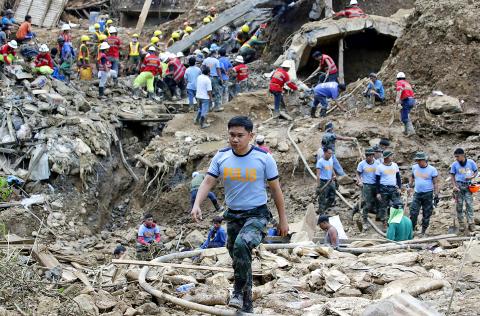A Philippine police officer who tried to persuade residents of a mining camp to move to safety as a powerful typhoon approached on Tuesday said they refused to leave and a day later the storm triggered a huge landslide that buried dozens of people.
Police Senior Inspector Heherson Zambale said in an interview that he was stunned after learning that the massive landslide had covered a chapel and bunkhouses in the mountain village where he and other officials had met with some of the victims a day before the tragedy struck on Saturday last week.
Typhoon Mangkhut, the most powerful storm to hit the Philippines this year, left at least 81 people dead and dozens of others missing, mostly in the avalanche in the gold-mining town of Itogon in Benguet province.

Photo: AP
The storm later blew on to Hong Kong and southern China, where it caused more deaths and damage.
Zambale said he and other local officials tried to convince the villagers, mostly small-scale miners and their families, to move to an evacuation center as the typhoon approached.
A villager officer who accompanied Zambale used a megaphone to warn people that Mangkhut was extraordinarily powerful and everybody should leave, he said.
The villagers told the police officer that they thought the chapel and nearby bunkhouses were on stable ground, and that they would only move away if the storm became severe, he said.
Zambale said he saw about 15 villagers outside the chapel and bunkhouses.
“Some were smiling and there were some who were just quiet. Some were listening to us,” he said.
Police photographs showed the officers in hard hats and light green raincoats talking with the villagers outside of what appears to be the concrete chapel and nearby bunkhouse, with piles of sandbags nearby.
Part of the mountain slope, covered in green foliage, can be seen behind the buildings.
Zambale, who has battled insurgents and criminals for eight years, said he had a bad feeling about the clearing where the buildings stood near a river, surrounded by tall mountains.
Some villagers heeded the warnings and left before the typhoon struck.
“But many were left behind,” Zambale said.
Rescuers have recovered 14 bodies from the avalanche and at least 58 other people remain missing, he said.
Itogon Mayor Victorio Palangdan on Monday said it was unlikely any of the missing were still alive, although rescuers continued to search.
Police Commander Rolando Nana said a special police unit scanned the landslide-hit area with radar that can detect heartbeats, but found no sign of life.
As more than 300 rescuers, including police and soldiers, used shovels and picks to search for the missing, Zambale said he still remembers the faces of the villagers he tried to convince to flee.
“I really feel sad, I cannot describe the emotion,” he said. “It’s not only the people who don’t listen. They have children, wives, elderly parents who will all suffer.”

Malaysia yesterday installed a motorcycle-riding billionaire sultan as its new king in lavish ceremonies for a post seen as a ballast in times of political crises. The coronation ceremony for Malaysia’s King Sultan Ibrahim, 65, at the National Palace in Kuala Lumpur followed his oath-taking in January as the country’s 17th monarch. Malaysia is a constitutional monarchy, with a unique arrangement that sees the throne change hands every five years between the rulers of nine Malaysian states headed by centuries-old Islamic royalty. While chiefly ceremonial, the position of king has in the past few years played an increasingly important role. Royal intervention was

X-37B COMPARISON: China’s spaceplane is most likely testing technology, much like US’ vehicle, said Victoria Samson, an official at the Secure World Foundation China’s shadowy, uncrewed reusable spacecraft, which launches atop a rocket booster and lands at a secretive military airfield, is most likely testing technology, but could also be used for manipulating or retrieving satellites, experts said. The spacecraft, on its third mission, was last month observed releasing an object, moving several kilometers away and then maneuvering back to within a few hundred meters of it. “It’s obvious that it has a military application, including, for example, closely inspecting objects of the enemy or disabling them, but it also has non-military applications,” said Marco Langbroek, a lecturer in optical space situational awareness at Delft

The Philippine Air Force must ramp up pilot training if it is to buy 20 or more multirole fighter jets as it modernizes and expands joint operations with its navy, a commander said yesterday. A day earlier US National Security Adviser Jake Sullivan said that the US “will do what is necessary” to see that the Philippines is able to resupply a ship on the Second Thomas Shoal (Renai Shoal, 仁愛暗沙) that Manila uses to reinforce its claims to the atoll. Sullivan said the US would prefer that the Philippines conducts the resupplies of the small crew on the warship Sierra Madre,

AIRLINES RECOVERING: Two-thirds of the flights canceled on Saturday due to the faulty CrowdStrike update that hit 8.5 million devices worldwide occurred in the US As the world continues to recover from massive business and travel disruptions caused by a faulty software update from cybersecurity firm CrowdStrike, malicious actors are trying to exploit the situation for their own gain. Government cybersecurity agencies across the globe and CrowdStrike CEO George Kurtz are warning businesses and individuals around the world about new phishing schemes that involve malicious actors posing as CrowdStrike employees or other tech specialists offering to assist those recovering from the outage. “We know that adversaries and bad actors will try to exploit events like this,” Kurtz said in a statement. “I encourage everyone to remain vigilant